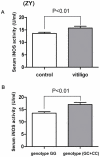Analysis of inducible nitric oxide synthase gene polymorphisms in vitiligo in Han Chinese people
- PMID: 22205923
- PMCID: PMC3244382
- DOI: 10.1371/journal.pone.0027077
Analysis of inducible nitric oxide synthase gene polymorphisms in vitiligo in Han Chinese people
Abstract
Background: Vitiligo is a chronic depigmented skin disorder with regional melanocytes depletion. The pathogenesis was not completely clarified. Recently, more and more evidence suggested that polymorphisms of some genes are associated with vitiligo risk. Here, we want to examine the association between the inducible nitric oxide synthase (iNOS) gene polymorphisms and the risk of vitiligo in Chinese populations.
Methods and principal findings: In a hospital-based case-control study of 749 patients with vitiligo and 763 age- and sex-matched healthy controls, three polymorphisms of iNOS gene were genotyped by using the PCR-restriction fragment length polymorphism (PCR-RFLP) and mutagenically separated PCR (MS-PCR) methods, respectively. We found the iNOS-954 polymorphism was associated with a significantly higher risk of vitiligo (adjusted OR = 1.36, 95% CI = 1.02-1.81). Furthermore, this association is more pronounced in vulgaris vitiligo, active vitiligo and vitiligo without other autoimmune diseases in the stratification study. Analysis of haplotypes showed increased risk for the C₋₁₁₇₃C₋₉₅₄C(Ex₁₆+₁₄) (OR = 1.44, 95% CI = 1.01-1.74). In addition, the serum iNOS activity is significantly associated with iNOS-954 combined genotype (GC+CC) and is much higher in vitiligo patients than in the controls (P<0.01). Logistic regression analysis of iNOS activity showed increased risk between higher activity and iNOS-954 G→C variant genotype carriers (P(trend)<0.001).
Conclusions and significance: INOS gene polymorphisms may play an important role in the genetic susceptibility to the development of vitiligo.
Conflict of interest statement
Figures

Similar articles
-
Inducible nitric oxide synthase promoter polymorphism: a molecular susceptibility marker for vitiligo in Egyptians.Int J Dermatol. 2015 Jun;54(6):675-9. doi: 10.1111/ijd.12716. Epub 2014 Dec 29. Int J Dermatol. 2015. PMID: 25556582
-
The association of functional polymorphisms in the aryl hydrocarbon receptor (AHR) gene with the risk of vitiligo in Han Chinese populations.Br J Dermatol. 2012 May;166(5):1081-7. doi: 10.1111/j.1365-2133.2011.10798.x. Br J Dermatol. 2012. PMID: 22211302
-
Genetic polymorphisms in the methylenetetrahydrofolate reductase gene (MTHFR) and risk of vitiligo in Han Chinese populations: a genotype-phenotype correlation study.Br J Dermatol. 2014 May;170(5):1092-9. doi: 10.1111/bjd.12845. Br J Dermatol. 2014. PMID: 24472005
-
Association of the 389 C/T polymorphism of the catalase gene with susceptibility to vitiligo: a meta-analysis.Clin Exp Dermatol. 2014 Jun;39(4):454-60. doi: 10.1111/ced.12340. Clin Exp Dermatol. 2014. PMID: 24825136 Review.
-
Identification of TNF-α as Major Susceptible Risk Locus for Vitiligo: A Systematic Review and Meta-Analysis Study in the Asian Population.Dermatology. 2024;240(3):376-386. doi: 10.1159/000536480. Epub 2024 Feb 20. Dermatology. 2024. PMID: 38377977
Cited by
-
Prevalence of polymorphisms in glucose-6-phosphate dehydrogenase, sickle haemoglobin and nitric oxide synthase genes and their relationship with incidence of uncomplicated malaria in Iganga, Uganda.Malar J. 2017 Aug 9;16(1):322. doi: 10.1186/s12936-017-1970-1. Malar J. 2017. PMID: 28793894 Free PMC article.
-
Differential Expression of Nitric Oxide Synthase Isoforms nNOS and iNOS in Patients with Non-Segmental Generalized Vitiligo.Int J Mol Sci. 2017 Nov 26;18(12):2533. doi: 10.3390/ijms18122533. Int J Mol Sci. 2017. PMID: 29186858 Free PMC article.
-
Modern vitiligo genetics sheds new light on an ancient disease.J Dermatol. 2013 May;40(5):310-8. doi: 10.1111/1346-8138.12147. J Dermatol. 2013. PMID: 23668538 Free PMC article. Review.
-
Inducible Nitric Oxide Synthase iNOS-954-G>C and Ex16+14-C>T Gene Polymorphisms and Susceptibility to Vitiligo in the Saudi Population.Pharmgenomics Pers Med. 2022 Jun 13;15:603-612. doi: 10.2147/PGPM.S344415. eCollection 2022. Pharmgenomics Pers Med. 2022. PMID: 35722629 Free PMC article.
-
Inducible nitric oxide synthase (iNOS) regulatory region variation in non-human primates.Infect Genet Evol. 2015 Apr;31:236-44. doi: 10.1016/j.meegid.2015.01.015. Epub 2015 Feb 9. Infect Genet Evol. 2015. PMID: 25675838 Free PMC article.
References
-
- Stromberg S, Bjorklund MG, Asplund A, Rimini R, Lundeberg J, et al. Transcriptional profiling of melanocytes from patients with vitiligo vulgaris. Pigment Cell Melanoma Res. 2008;21:162–171. - PubMed
-
- Alkhateeb A, Fain PR, Thody A, Bennett DC, Spritz RA. Epidemiology of vitiligo and associated autoimmune diseases in Caucasian probands and their families. Pigment Cell Res. 2003;16:208–214. - PubMed
-
- Le Poole IC, Das PK, van den Wijngaard RM, Bos JD, Westerhof W. Review of the etiopathomechanism of vitiligo: a convergence theory. Exp Dermatol. 1993;2:145–153. - PubMed
-
- Lowenstein CJ, Dinerman JL, Snyder SH. Nitric oxide: a physiologic messenger. Ann Intern Med. 1994;120:227–237. - PubMed
-
- Kharitonov SA. NOS:molecular mechanisms, clinical aspects, therapeutic and monitoring approaches. Curr Drug Targets Inflamm Allergy. 2005;4:141–149. - PubMed
MeSH terms
Substances
LinkOut - more resources
Full Text Sources
Medical
Miscellaneous

